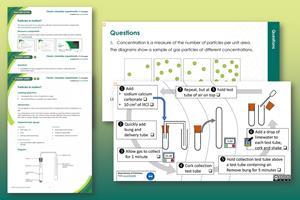Explore the movement of gas particles by reacting calcium carbonate with hydrochloric acid and testing with limewater
-

Download this
Everything you need to run this practical lesson with classroom slides, scaffolded and unscaffolded student worksheets and teacher guidance, including full technical notes and answers to all questions.
View and download more Classic chemistry experiments
Learners produce carbon dioxide by reacting calcium carbonate with hydrochloric acid. They then check to see if diffusion occurs by holding the test tube of carbon dioxide over a test tube of air and vice versa.
Learning objectives
- Investigate the motion of particles in a gas.
- Use particle theory to explain your observations.
Learning objective 1 will be met by carrying out the complete practical and watching the optional teacher demonstration of Brownian motion.
Learning objective 2 will be met through small group/whole class discussions and answering the questions.
Scaffolding
There are two versions of the student worksheet: scaffolded (✪) and unscaffolded (✪✪). The scaffolded sheet offers more support for learners.
Integrated instructions are available in the PowerPoint presentation. There is also a list of key terms, for both equipment and chemistry. These key terms can be used to check for understanding and to activate previous knowledge at the start of the lesson using a mini whiteboard activity. Find more support for literacy and vocabulary in our Key Terms support bundle for 11-14 Particle model.
Technician notes
Read our standard health and safety guidance and carry out a risk assessment before running any live practical.
Equipment (per group)
Apparatus
- Test tubes, x 3
- Cork
- Delivery tube and bung
Chemicals
- Limewater 0.02 mol dm-3
- Calcium carbonate
- Hydrochloric acid 0.5 mol dm-3
Safety equipment
- Eye protection: safety glasses to EN166F
Safety, hazards and disposal
- At this concentration hydrochloric acid is not classed as hazardous but use eye protection even when using dilute solutions, see CLEAPSS Hazcard HC047a. Teachers in Scotland should refer to SSERC for guidance.
- Avoid inhaling fumes.
- Neutralise and dilute hydrochloric acid to below 0.1M before disposing via a foul-water drain.
Procedure

- Wear safety glasses.
- Set up the apparatus as shown in the diagram.
- Put a spatula of calcium carbonate into the first test tube.
- Add 10 cm3 of hydrochloric acid and quickly replace the bung and delivery tube. Ensure the delivery tube reaches almost to the bottom of the second test tube.
- Allow the carbon dioxide gas to pass into the second test tube for about 1 minute, then remove the delivery tube and cork the test tube.
- Hold the test tube of carbon dioxide gas upside down over a similar test tube containing air.
- Remove the cork and place the tubes mouth-to-mouth.
- After 5 minutes, cork both tubes and test the contents for carbon dioxide (swirl a little limewater round in the test tube). Write down what happens in both tubes.
- Repeat this experiment but this time at step 5 hold the test tube of air upside down over the test tube of carbon dioxide.
Teaching notes
Particles in motion is an abstract idea. Use familiar images to introduce it, such as the one on slide 2, and to stimulate discussion at the start of the lesson.
Explain that particles in the gas state are in continuous motion. Scientists have built up a body of evidence proving this with a range of different experiments. Ask your learners for examples of evidence for moving particles e.g. dust being blow about in the air or sun shining through a crack in the drawn curtains, showing dust in the air.
You could demonstrate or use a video clip to show Brownian motion in a smoke sample, as further evidence of particles in motion, before moving onto the class practical. This video also contains a useful model to show how the particles of a substance in the gas state move. Alternatively Brownian motion may be used to reinforce ideas once the practical is completed.
This experiment enables learners to explore the motion of particles in a gas. The learners generate (and collect) carbon dioxide by mixing calcium carbonate and hydrochloric acid. They then allow the carbon dioxide to diffuse into an empty test tube. Next, learners carry out a chemical test to confirm that carbon dioxide particles have moved into the empty test tube. Learners should then apply their previous learning about particle theory to explain their observations.
This experiment does not prove particulate theory, but it does show that the particles in the gas must be in motion to spread through the air and into the other test tube. If the particles didn’t move, carbon dioxide would not be found in both test tubes.
Downloads
Particles in motion presentation slides
Presentation | PDF, Size 0.94 mbParticles in motion student sheet
Handout | PDF, Size 0.23 mbParticles in motion student support sheet
Handout | PDF, Size 0.26 mbParticles in motion teacher notes
Handout | PDF, Size 0.48 mbParticles in motion presentation
Presentation | PowerPoint, Size 2.43 mbParticles in motion student sheet
Editable handout | Word, Size 0.6 mbParticles in motion student support sheet
Editable handout | Word, Size 0.61 mbParticles in motion teacher notes
Editable handout | Word, Size 1.4 mb
Additional information
This practical is part of our Classic chemistry experiments collection. The supporting resources were updated in 2025 by Dorothy Warren.

































No comments yet